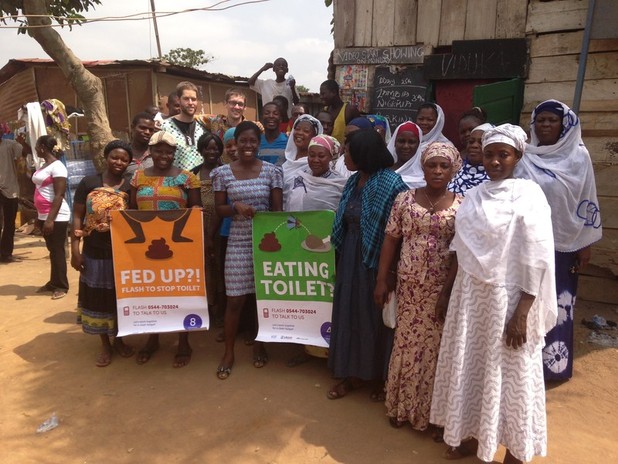September 18, 2013
IDEO.org fellow, John Won, meets with WSUP’s community organizer in Kumasi, Ghana to get an update on the progress of #Crapmap, a digital platform designed to encourage community members to get involved in improving local sanitation.
One by one, Ayigya Zongo's dumping areas are disappearing. These swaths of land were once crowded with household trash and "flying toilets,” black plastic bags containing human waste. Last Stop and Bolatongo, previously among some the worst sites by size and risk to residents, have now been cleaned up. Ayigya Zongo's Water and Sanitation Committee is responsible for these community-led changes.
Faustina Asante, a community organizer with IDEO.org’s partner Water and Sanitation for the Urban Poor (WSUP), spoke with me recently about her collaboration with the Committee and their accomplishments. The Committee emerged out of the crapmap project in November 2012 in which IDEO.org, WSUP, and USAID partnered to design and test a digital prototype of a platform to mobilize collective action.
As you may recall from the beginning of this project, the original design brief and prototype took a significantly different approach to the issue of sanitation in Kumasi - using open-source digital tools to map open defecation. It was apparent after testing in the field, that this prototype was not a well-suited approach for our target population, and it was only through human-centered design and a nimble design team that we were able to redirect our efforts towards a new prototype. Read a previous blog post here to learn about the insights and design shift, which refocused the project on a platform to spur community engagement.
The current platform aims to spur collective, community-led action against open defecation in a low-income urban neighborhood of Kumasi, Ghana called Ayigya Zongo. Since this shift, the team has engaged over 30 individuals, participating in community meetings and clean-ups. This core group includes the leader of the women's committee who first welcomed the project to Ayigya Zongo, the community chief and sub-chiefs, the youth committee leader, and other concerned residents.
A week of awareness, education, and advocacy
As you may remember from our latest photo update, the Committee completed its first "Sanitation Week" in April - a series of awareness events, community outreach activities, and an appearance on local media. Organizers went door to door in focus areas, speaking with residents and posting stickers to promote their message. This effort encouraged residents to flash the digital platform's phone number to receive a callback. Organizers then followed-up by inviting these residents to participate in meetings and Sanitation Week events. At one event, children were invited up to a hand-washing station and the audience was asked to identify proper and improper hygiene techniques. The capstone of the week was a public radio show enabling Ayigya Zongo residents and leaders to share their experiences and advocate the need for improved sanitation in the community.
Community-led change
During the past several months, Faustina and WSUP have focused on organizing local residents, leaders, and other stakeholders in building a foundation for sustainable community-led change. While reducing open defecation and improving sanitation conditions remain the immediate goals of the Committee, they have outlined other community-health efforts as well, including a "Keep Fit" club to engage residents in group exercise activities.
What's next
Bolatongo is a prime example of community-led change achieved by the Committee and residents. In the past, Bolatongo was a major marketplace, but after becoming abandoned it became a de facto dumping site where residents often visited to "ease" themselves. This year, the Committee has refocused attention on the area and led a community clean-up. Local officials have even introduced a plan to develop the area for public use, including a proposal for a community center and police station.
With the WSUP and IDEO.org campaign coming to a close, it’s great to reflect on the changes that the program has undergone in one year. What began as a hypothesis to see if we could map open-defecation hotspots with mobile/SMS technology has evolved into a digital platform to enable collective-action and spark broader community development by local residents. Keep posted for a #crapmap year in review, with design team fellow, John Won, and find out more about the lessons learned during the process.
***
This project is made possible by the generous support of the American people through the United States Agency for International Development (USAID). The contents of this story are the responsibility of IDEO.org and do not necessarily reflect the views of USAID or the United States Government.








